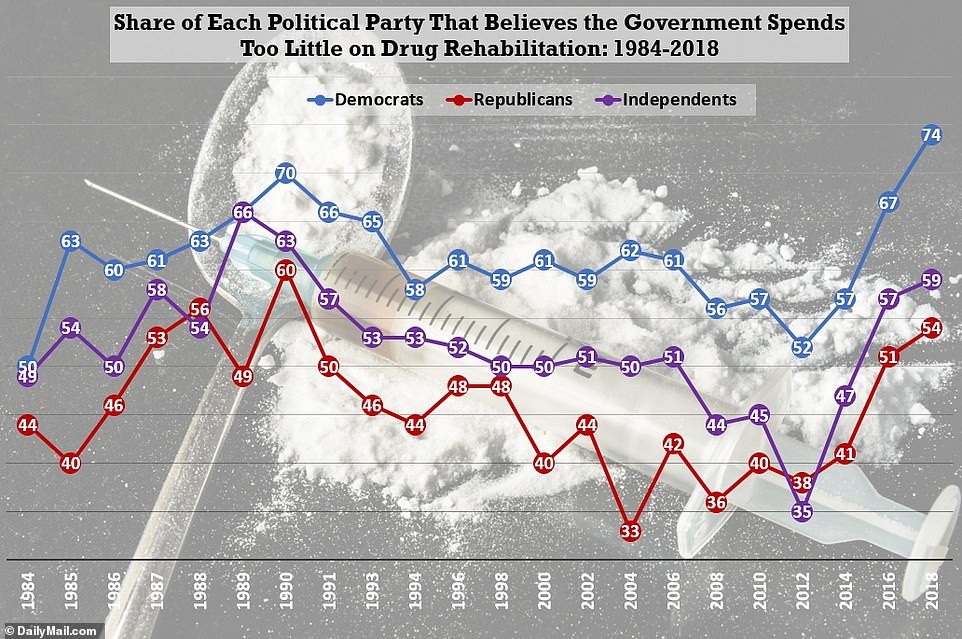By Valerie Bauman, Social Issues Reporter
The Daily Mail (UK)
- Exclusive DailyMail.com analysis of the General Social Survey reveals a 50% increase since 2012 in the share of Americans who believe the federal government does not spend enough on drug addiction rehabilitation
- It marks a major shift in attitude following the emergence of the opioid epidemic, as more white Americans begin to view addiction as a disease rather than as a personal failing that primarily affects people of color
- African Americans are still significantly more likely to call for greater spending on drug addiction rehabilitation, with 71% supporting such investments in 2018 compared to 62% of white Americans
Nearly two-thirds of Americans (63 percent) believe the government spends too little on drug rehabilitation – an attitude increasingly embraced by white Americans as addiction becomes viewed more as a disease and less as a personal failing that primarily affects minorities, according to new survey data.
It represents a 50 percent increase since 2012 when just 42 percent of Americans felt that way, according to an exclusive DailyMail.com analysis of the General Social Survey – a comprehensive poll that has tracked American attitudes and beliefs since 1972.
The shift in attitudes is ‘encouraging,’ said Michael Botticelli, executive director of the Grayken Center for Addiction at Boston Medical Center, and former director of National Drug Control Policy at the White House under former President Obama.
‘It’s also heart-breaking at the same time that it took this level of addiction and death to change the (public) opinion here,’ he told DailyMail.com. ‘It’s particularly tragic that we didn’t see this kind of response where previous epidemics largely affected people of color.’

This graph illustrates the share of all Americans who believe the government spends too little on drug rehabilitation. Source: General Social Survey
The share of all Americans who would like to see more spending on rehabilitation is now approaching the peak of 1990 – during the height of the crack epidemic – when 65 percent said the government spent too little on rehabilitation.
Overall support for increased funding fell steadily from 1990 through 2012, just as the opiate crisis was about to take hold and capture media attention.
‘The coverage of the opioid epidemic has gotten greater attention than anything in the drug arena over the last 30, 40 years,’ said Peter Provet, CEO of the New York City-based Odyssey House rehabilitation center.
Black and white Americans have historically been sharply divided on this issue, with African Americans significantly more likely to be in support of more funding for drug rehab than their white counterparts – with calls for more spending ranging from 60 percent to more than 80 percent over the past three decades.
This support peaked among African Americans in 1990 (again, during the height of the crack epidemic, which disproportionately affected black people), when 83 percent said more funding was needed – compared to an all-time peak of 62 percent of white Americans that year.

This graph illustrates the share of black and white Americans who believe the government spends too little on drug rehabilitation. Source: General Social Survey
White attitudes tied that peak in 2018, with 62 percent in favor of more spending on rehabilitation – a 63 percent increase since 2012 when just 38 percent felt that way.
It’s still significantly less than the 71 percent of African Americans in 2018 who said they would like to see more funding dedicated to helping people recover from drug addiction.
The change in attitudes is a good sign, because the general public and politicians have ‘never adequately seen the drug issue as a big enough concern,’ Provet told DailyMail.com.
‘The historical demographic (of drug addiction) has been the poor, primarily black or person of color, inner city addict and that demographic has not gotten the general public’s concern and attention,’ he added. ‘This current opioid epidemic has struck far more into the middle class of America.’
Opinions on rehabilitation spending also split along partisan lines, with 74 percent of Democrats saying it’s underfunded in 2018, compared to 53 percent of Republicans and 59 percent of Independents.
Among Democrats, 2018 marks a record high in public opinion in favor of more funding for those suffering from addiction, while Republicans saw a peak in 1990 at 60 percent, and Independents in 1989 at 66 percent.

This graph illustrates the share of Americans of different political parties who believe the government spends too little on drug rehabilitation. Source: General Social Survey
All three political parties have seen a steady uptick in support for government funding since 2012.
The opioid epidemic has managed to capture more public sympathy than other drug epidemics, largely because it affects so many people – and due to its reach into suburban white America, Botticelli said.
‘The vast majority of people know someone who has been affected by the opioid epidemic,’ he said.
The result has even led to a shift in attitudes among many in law enforcement.
‘You have more and more law enforcement officials saying we can’t arrest and incarcerate our way out of this problem,’ Botticelli said.
‘If you look at where we’ve funded other epidemics like HIV and tobacco, not only do we need to increase the resources, but that funding needs to be sustained over time,’ he added.
The Department of Health and Human Services is requesting $1.9 billion in funding for substance abuse prevention and treatment in the 2020 federal budget proposal, though officials have not broken out how much of that is designated for rehabilitation.

